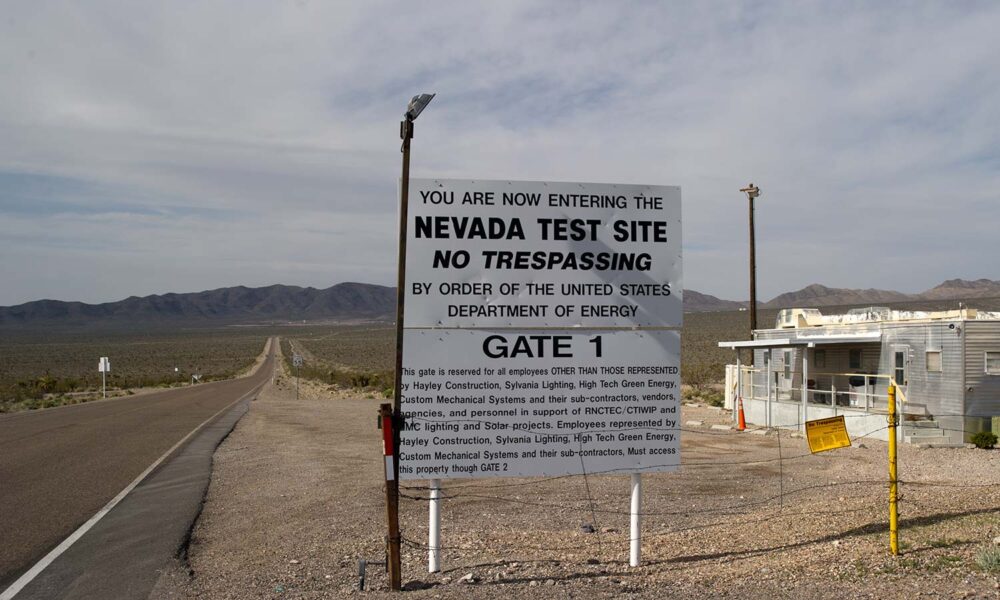After almost thirty years, the US is suddenly contemplating a return to nuclear testing. The Senate Armed Services Committee version of the FY21 National Defense Authorization Act provides “no less than $10 million” to “carry out projects related to reducing the time required to execute a nuclear test if necessary.” This follows reports in May that senior Trump administration officials were considering conducting a test as a way to pressure Russia and China to engage in nuclear arms control negotiations. On June 24, the administration’s envoy for arms control told reporters that he was “unaware of any particular reason to test at this stage,” but also refused to rule out the possibility, asking “why would we?”
The administration’s own 2018 Nuclear Posture Review (NPR) states that the “US will not resume nuclear explosive testing unless necessary to ensure the safety and effectiveness of the U.S. nuclear arsenal, and calls on all states possessing nuclear weapons to declare or maintain a moratorium on nuclear testing.” And, according to a letter to Congress from a group of scientists with nuclear weapons expertise “there is no technical or military need to conduct a nuclear explosive test….doing so would have serious negative security consequences for the US.”
Following are some key questions and responses about a potential resumption of US nuclear explosive testing.
When was the last time the US tested a nuclear weapon?
The US tested nuclear weapons in the atmosphere until July 1962 and then continued testing underground for another thirty years. “Divider,” the last US underground nuclear test, exploded on September 23, 1992 at the Nevada Nuclear Test Site. It was test number 1,054 since the US first developed nuclear weapons in 1945—more than all the other nuclear states combined. Following this test, President George H.W. Bush signed a 9-month moratorium on US nuclear testing. President Clinton extended the ban and, in 1996, the US signed the Comprehensive Test Ban Treaty (CTBT), which prohibits all explosive nuclear testing.
Do any other states still test their nuclear weapons?
North Korea is the only state to conduct a nuclear explosive test since 2000. All other states stopped in the 1990s: the Soviet Union in 1990; the United Kingdom in 1991; and France and China in 1996. India and Pakistan carried out tit-for-tat tests in 1998, before each declared its own unilateral moratorium on testing.
A State Department report released in April 2020 alleges that Russia has conducted very-low-yield nuclear tests that would violate the CTBT. The report also raises “concerns” about China’s compliance with the treaty’s zero-yield standard. (Russia has ratified the treaty but China, like the US, has only signed it). The CTBT Organization’s extensive worldwide monitoring network has not confirmed these allegations. Regardless of their truth, however, a 2012 study by the US National Academy of Sciences found that very-low-yield nuclear tests would not provide any significant advantage.
Why did the US stop testing?
The end of the Cold War shifted focus for the US and Russia from building up to reducing their arsenals of tens of thousands of nuclear weapons. And Soviet leader Mikhail Gorbachev’s unilateral testing moratorium in October 1991 made it easy for the US to announce its own moratorium in 1992. Environmental concerns also played a role. While the risks of atmospheric nuclear testing are obvious, even underground testing can have serious health and environmental consequences. Earlier US underground tests, such as Sedan in 1962 and Baneberry in 1970, released large amounts of radioactive fallout. The US is still dealing with the devastation that its testing program caused to residents in the areas where tests were carried out, and there is still no method for cleaning up the plutonium and other long-lived radionuclides that were left underground at the test sites.
How might other countries respond to renewed US nuclear testing? Would it really get Russia and China to the negotiating table?
If the US resumed nuclear testing, the ensuing international chain reaction would be unpredictable but undoubtedly destabilizing. Every other nuclear-armed state also has the capacity to return to testing, and a US test could give those that wanted to cover to do so. As noted above, the US has conducted many more tests than anyone else, so other states would have far more to gain from renewed testing.
At the same time, a resumption of testing could dangerously erode confidence in the system of treaties and agreements that keep other states from acquiring nuclear weapons. In the worst-case scenario, a resumption of US nuclear testing could lead additional states to decide that they need to begin their own nuclear weapons programs to ensure their security, triggering the collapse of the nuclear nonproliferation regime. In short, a US test could ignite or exacerbate arms races around the globe, ultimately leaving all states less secure.
But while the precise response of any specific state to a US test is uncertain, one outcome is not: a test would not force Russia and China to the negotiating table with the US. The obstacles to a trilateral nuclear arms control treaty are much more complex than heavy-handed pressure tactics can overcome.
If the US no longer tests its nuclear weapons, how do we know that they will still work?
Surprisingly, very few US explosive nuclear tests —17 out of more than 1,000—were conducted to verify the reliability of existing US weapon types. The vast majority tested new warhead designs, perfected designs before deployment, and studied the effects of nuclear weapons. Since 1995, the US has invested tens of billions of dollars in the science-based Stockpile Stewardship Program, allowing it to carry out a wide range of diagnostic, non-nuclear tests and assessments to ensure that its nuclear weapons remain safe, reliable, and militarily effective. Using experimental facilities for non-nuclear testing, and powerful supercomputers to model US nuclear weapons, the directors of US nuclear weapons laboratories each year since 1996 have provided their assessment of the safety, reliability, and military effectiveness of each weapon in the US nuclear arsenal. They are charged with evaluating whether explosive nuclear testing is needed to address any identified problems. For twenty-five years, the directors have certified to the president each year that the arsenal remains safe, reliable, and effective, and that a resumption of nuclear explosive testing is not needed.
Can the US legally resume nuclear testing?
The US is party to two treaties that prohibit testing nuclear weapons in the atmosphere, in space, and underwater and prohibit tests that exceed 150 kilotons of explosive force: the 1963 Partial Test Ban Treaty and the 1974 Threshold Test Ban Treaty.
In 1996, the US was the first country to sign the Comprehensive Test Ban Treaty, which bans all nuclear explosions. Since the US Senate has still not ratified the CTBT, a US test technically would not violate the treaty. Normally, however, the US is obliged to refrain from actions that would defeat the object and purpose of a treaty it has signed, even before ratification. The current case is more complicated, because while the Trump administration has not gone so far as to “unsign” the CTBT, its 2018 NPR declared that it would not seek ratification, leaving US obligations to the treaty unclear.
But regardless of the legal status of US obligations while the treaty is in limbo, the bottom line is that the Trump administration clearly does not believe there is any legal barrier to resuming testing.
How long would it take the US to resume nuclear testing if it decided to do so?
When the US regularly carried out explosive nuclear tests, the time required to design and prepare for most tests was about 18 months. Since the 1992 moratorium, the readiness requirement shifted to 24-36 months preparation to conduct a test. These timelines, however, assume a test that would be conducted to gain useful information about the weapon being tested—something that requires extensive use of diagnostic equipment. If the aim were simply to carry out a test for political reasons, officials have indicated that it could happen much faster, in a matter of months.
Who makes the decision about whether to hold a nuclear test?
Ultimately, the decision to carry out a nuclear test rests with the president. Congress could try to prohibit money being spent for a test, but such a law would still need to be signed by the president unless it was passed by a veto-proof majority. No current law could stop a presidential decision to test.
The featured image in this blog is courtesy of B. Ebbesen/Wikipedia.

